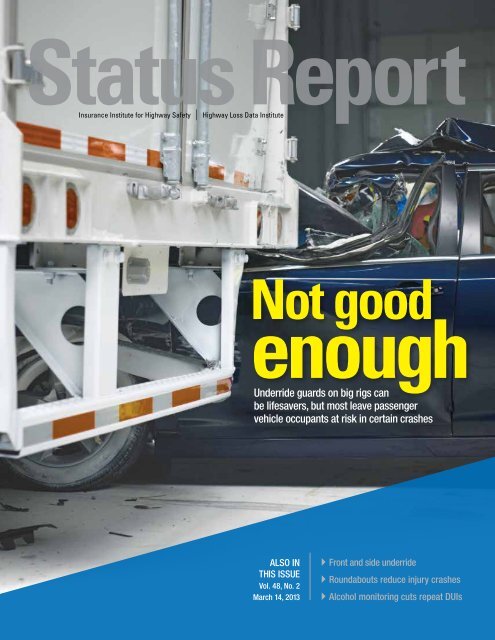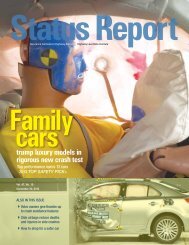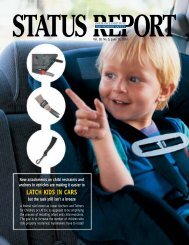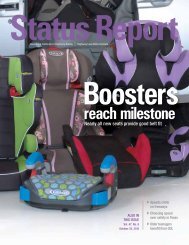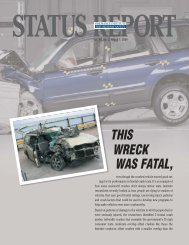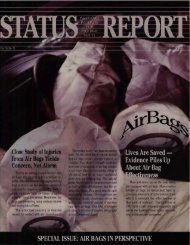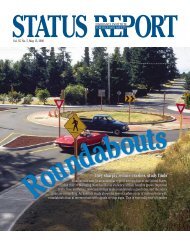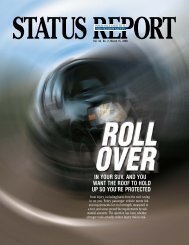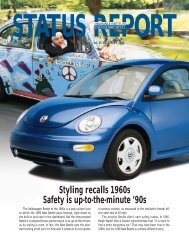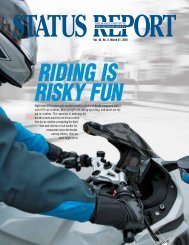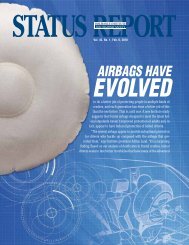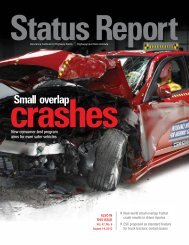IIHS Status Report newsletter, Vol. 48, No. 2, March 14, 2013
IIHS Status Report newsletter, Vol. 48, No. 2, March 14, 2013
IIHS Status Report newsletter, Vol. 48, No. 2, March 14, 2013
You also want an ePaper? Increase the reach of your titles
YUMPU automatically turns print PDFs into web optimized ePapers that Google loves.
<strong>Status</strong> <strong>Report</strong><br />
Insurance Institute for Highway Safety | Highway Loss Data Institute<br />
<strong>No</strong>t good<br />
enough<br />
Underride guards on big rigs can<br />
be lifesavers, but most leave passenger<br />
vehicle occupants at risk in certain crashes<br />
Also In<br />
this issue<br />
<strong>Vol</strong>. <strong>48</strong>, <strong>No</strong>. 2<br />
<strong>March</strong> <strong>14</strong>, <strong>2013</strong><br />
4Front and side underride<br />
4Roundabouts reduce injury crashes<br />
4Alcohol monitoring cuts repeat DUIs
<strong>IIHS</strong> crash tested eight semitrailers to see if their underride guards could<br />
stop a car from sliding underneath the trailers. Most prevented underride<br />
in the two easier tests. Only one trailer passed the toughest test, a 30 percent overlap.<br />
Modern semitrailers for the most part do a good job of keeping<br />
passenger vehicles from sliding underneath them, greatly<br />
increasing the chances of surviving a crash into the back of<br />
a large truck, recent <strong>IIHS</strong> crash tests show. But in crashes involving<br />
only a small portion of the truck’s rear, most trailers fail to prevent<br />
potentially deadly underride.<br />
Most semitrailers are required to have underride guards. These<br />
are steel bars that hang from the backs of trailers to prevent the front<br />
of a passenger vehicle from moving underneath during a crash.<br />
Earlier research showed the minimum strength and dimensions required<br />
for underride guards in the U.S. are inadequate, prompting<br />
<strong>IIHS</strong> to petition the National Highway Traffic Safety Administration<br />
(NHTSA) in 2011 for tougher standards. The Institute also asked the<br />
agency to consider applying the standards to other large trucks such<br />
as dump trucks that aren’t required to have any underride guards<br />
(see <strong>Status</strong> <strong>Report</strong>, <strong>March</strong> 1, 2011, at iihs.org).<br />
Although NHTSA hasn’t responded yet, trailer manufacturers already<br />
are installing guards that are much stronger than required.<br />
8<br />
passed 100% full-width test<br />
Great Dane, Hyundai, Manac, Stoughton,<br />
Strick, Utility, Vanguard, Wabash<br />
7passed 50% overlap test<br />
Great Dane, Hyundai, Manac,<br />
Stoughton, Strick, Utility, Wabash<br />
2 |<br />
<strong>Status</strong> <strong>Report</strong> — <strong>Vol</strong>. <strong>48</strong>, <strong>No</strong>. 2
30% overlap Test 4 Passed<br />
30%<br />
overlap Test<br />
8 Failed<br />
The Manac trailer was the only one to pass the 30 percent overlap.<br />
The Utility underride guard’s failure in the 30 percent test was typical.<br />
100% full-width Test 50%<br />
4 Passed overlap Test 4 Passed<br />
The Hyundai trailer’s redesigned underride guard did well in the full-width test.<br />
1passed 30%<br />
overlap test<br />
Manac<br />
These guards generally work well to prevent underride, except in<br />
crashes occurring at the outer edges of trailers, the crash tests show.<br />
One likely reason manufacturers are installing guards that are stronger<br />
than required is a tougher standard that trailers in Canada have<br />
had to meet since 2007. More recently, <strong>IIHS</strong> crash tests have drawn<br />
attention to the issue, and at least one manufacturer has started selling<br />
a trailer with an improved underride guard since the tests began.<br />
To see how well the latest guards work, <strong>IIHS</strong> engineers put trailers<br />
from the eight largest manufacturers through a series of progressively<br />
tougher crash tests. These<br />
manufacturers made about<br />
80 percent of heavy trailers<br />
produced in <strong>No</strong>rth<br />
America in 2011.<br />
All the trailers<br />
had underride<br />
guards that met<br />
both U.S. and<br />
Stoughton’s underride guard performed well in the 50 percent overlap.<br />
Canadian standards. Both standards require the guard to withstand a<br />
certain amount of force at various points. Under the Canadian regulation,<br />
a guard must withstand about twice as much force as required<br />
by the U.S. rule at the point where it attaches to its vertical support.<br />
In each crash test, a 2010 Chevrolet Malibu struck a parked truck<br />
at 35 mph. In the first scenario, the car was aimed at the center of the<br />
trailer. All eight guards successfully prevented underride, including<br />
one from Hyundai Translead, whose earlier model failed a full-width<br />
test by <strong>IIHS</strong>. In the second test, in which only half the width of the<br />
car overlapped with the trailer, all but one trailer passed. However,<br />
when the overlap was reduced to 30 percent, every trailer except one<br />
from the Canadian manufacturer Manac failed. Manac sells dry van<br />
trailers in the U.S. under the name Trailmobile. The Institute uses a<br />
30 percent overlap for the most challenging underride test because it<br />
is the minimum overlap under which a passenger vehicle occupant’s<br />
head is likely to strike a trailer if an underride guard fails.<br />
“Our tests suggest that meeting the stronger Canadian standard<br />
is a good first step, but Manac shows it’s possible to go much<br />
<strong>March</strong> <strong>14</strong>, <strong>2013</strong> |<br />
3
the Malibu’s structure and airbags protected<br />
the dummy, and injury measures were generally<br />
low and not life-threatening. In contrast,<br />
when the guards failed, head and neck<br />
injury measures were so high that real drivers<br />
would have died.<br />
In 2011, 260 of the 2,241 passenger vehicle<br />
occupants killed in large truck crashes died<br />
when the fronts of their vehicles struck the<br />
rears of trucks. That’s down from 460 out of<br />
3,693 in 2004. The decline is likely due in part<br />
to changes in traffic amid the weak economy.<br />
Gaps in federal data make it difficult to pinpoint<br />
how many crashes involve underride.<br />
A 2011 <strong>IIHS</strong> study of 115 crashes in which a<br />
passenger vehicle struck the back of a heavy<br />
truck or semitrailer found only about onefifth<br />
involved no underride or negligible underride.<br />
Nearly half of the vehicles had severe<br />
or catastrophic underride damage, and they<br />
accounted for 23 of the 28 fatal crashes in the<br />
study. More than half the trucks weren’t required<br />
to have underride guards.<br />
The vertical supports of Manac’s underride<br />
guard are located closer to the edge of the<br />
trailer. That difference is what prevented<br />
underride in the 30 percent overlap crash.<br />
makes a difference<br />
10 ” The supports of Manac’s<br />
guard are located 18 inches<br />
from the edge, compared<br />
with an average of 28<br />
inches on other trailers.<br />
Manac<br />
Others<br />
further,” says David Zuby, the Institute’s<br />
chief research officer.<br />
The danger of underride<br />
All the improvements in occupant protection<br />
that have helped drive down crash<br />
deaths in recent decades count for little<br />
when the front of a passenger vehicle ends<br />
up under a truck. When this happens, the<br />
top of the occupant compartment gets<br />
crushed because the vehicle structures designed<br />
to absorb crash energy are bypassed.<br />
Airbags and safety belts can’t do their jobs,<br />
and people inside the vehicle can experience<br />
life-threatening head and neck injuries.<br />
The crash tests show how this occurs. The<br />
2010 Malibu was an <strong>IIHS</strong> TOP SAFETY<br />
PICK, and in the 40 mph moderate overlap<br />
barrier test used to evaluate the car’s frontal<br />
crashworthiness, measurements recorded<br />
by a dummy in the driver seat indicated serious<br />
injuries were unlikely. Similarly, in the<br />
underride tests in which the guards held up,<br />
Crash test results<br />
The Institute previously released the results<br />
of an initial round of crash testing on three<br />
semitrailers conducted in 2010 and 2011.<br />
The weakest guard tested at that time was<br />
from Hyundai. It met the U.S. standard for<br />
strength but not the Canadian one. When<br />
the Malibu hit the center of the trailer in a<br />
full-width crash, the guard broke, resulting<br />
in catastrophic underride. In 50 percent<br />
overlap tests, the underride guard on a Vanguard<br />
trailer allowed moderate underride at<br />
25 mph and severe underride at 35 mph.<br />
In contrast, a Wabash trailer had no underride<br />
in either the full-width or the 50<br />
percent overlap test. However, when it was<br />
put through the 30 percent overlap test, the<br />
underride was catastrophic. That’s because<br />
the car hit the guard outside its vertical attachment<br />
bar, causing the unsupported end<br />
to bend forward. The Wabash underride<br />
guard hasn’t been redesigned since then.<br />
“This weakness at the ends is the same problem<br />
we saw in all the trailers that passed the 50<br />
percent overlap but failed the 30 percent over<br />
the course of our testing,” says Matthew Brumbelow,<br />
an <strong>IIHS</strong> senior research engineer.<br />
Since the initial evaluations, <strong>IIHS</strong> tested<br />
Hyundai and Vanguard trailers again after<br />
the companies made changes to their underride<br />
guards. Trailers from five more companies<br />
also were tested. All eight manufacturers<br />
4 |<br />
<strong>Status</strong> <strong>Report</strong> — <strong>Vol</strong>. <strong>48</strong>, <strong>No</strong>. 2
now have underride guards meeting the Canadian<br />
standard, and none of the current designs had any<br />
difficulty passing the full-width test. Most passed<br />
the 50 percent overlap test, too. The exception was<br />
the Vanguard. The guard’s vertical support broke<br />
off the trailer when the guard was hit by the car,<br />
just as it did in the test of the previous design.<br />
“Vanguard’s older and newer underride guards<br />
were certified to the Canadian standard, so clearly<br />
the Canadian regulation, while an improvement<br />
over the U.S. rule, isn’t stringent enough,” Zuby<br />
says. “Failing the 50 percent test is a big problem<br />
because in our analysis of real-world crashes with<br />
the rears of trucks, about half of those with severe<br />
underride had overlaps of 50 percent or less.”<br />
A better design<br />
Although the rest of the trailers passed the 50<br />
percent overlap test, most failed the 30 percent.<br />
The problem stems from the location of the underride<br />
guards’ vertical supports. On most trailers,<br />
the supports are attached to the slider rails,<br />
which run lengthwise under the trailer and<br />
allow the position of the wheels to be changed<br />
depending on the load. Using this structure as<br />
the underride guard’s attachment point means<br />
the vertical supports are located an average of 28<br />
inches from the trailer’s edge.<br />
Manac, the only trailer to pass the 30 percent<br />
test, takes a different approach. The company’s<br />
engineers realized the supports should be spread<br />
further apart to transfer more strength from the<br />
center to the outer ends of the guard, says Manac<br />
President Charles Dutil. They decided to attach<br />
the supports to a reinforced floor and spaced them<br />
just 18 inches from the edge. The result is a better<br />
design but not a huge additional cost, he says.<br />
The Manac underride guard “doesn’t weigh<br />
200 pounds more than anybody else’s; it doesn’t<br />
cost $200 more,” Dutil says, estimating the difference<br />
to be at most 20 pounds and $20. The design<br />
of the mounting not only does a better job preventing<br />
underride but also minimizes damage to<br />
the trailer itself in rear crashes, he notes.<br />
That held true in the <strong>IIHS</strong> crash tests. The<br />
Manac trailer had damage estimates that were<br />
among the lowest of all the trailers, requiring<br />
only a replacement underride guard.<br />
“If trailer manufacturers can make guards<br />
that do a better job of protecting passenger vehicle<br />
occupants while also promising lower repair<br />
costs for their customers, that’s a win-win,” Zuby<br />
says. “While we’re counting on NHTSA to come<br />
up with a more effective regulation, we hope that<br />
in the meantime trailer buyers take note of our<br />
findings and insist on stronger guards.” n<br />
Rear underride crashes are easier<br />
to address than front or side ones<br />
A hurried driver looks over his shoulder as he tries to merge onto the freeway, failing to notice traffic<br />
stopped ahead of him. He plows his van into the back of a tractor-trailer.<br />
A Chevrolet Prizm slams into the side of a tractor-trailer as it makes a U-turn from the opposite direction<br />
at a traffic signal while both vehicles have the green light.<br />
The driver of a logging truck sees a Ford Explorer coming toward him in his lane on a rural, undivided<br />
highway. Both vehicles move into the other lane at the last minute and crash head-on.<br />
All of these examples were taken from a federal database of truck crashes, and each resulted in the<br />
death of the passenger vehicle driver. In the first, the outcome may well have been different if the truck<br />
had been equipped with a stronger rear underride guard such as those already on some trailers. In the<br />
second two crashes, which involved the side of one large truck and the front of the other, potential solutions<br />
exist, but they aren’t as readily available.<br />
Crashes involving the rear of a large truck account for about one-fifth of fatal underride cases, Institute<br />
researchers found in 1997. Another<br />
fifth are side crashes, while the majority are<br />
frontal ones. Unlike front and side underride,<br />
rear underride fatalities are often preventable,<br />
and there is a framework in place to<br />
address the problem.<br />
“We already have a regulation on rear underride<br />
guards, so we should make sure that<br />
regulation is effective,” says Matthew Brumbelow,<br />
an <strong>IIHS</strong> senior research engineer.<br />
Still, with so many underride crashes involving<br />
the fronts and sides of large trucks,<br />
should guards surround trucks completely?<br />
In side crashes, underride guards have<br />
the potential to save lives. An <strong>IIHS</strong> analysis<br />
of crashes in which passenger vehicles hit<br />
the side of large trucks found that out of <strong>14</strong>3<br />
crashes in which the truck side impact produced<br />
the most severe injury, more than half<br />
would not have been as severe if there had been side underride guards on the truck.<br />
In this 2002 fatal underride crash, a Chevrolet Impala was<br />
hit by another vehicle from behind, lost control and struck<br />
the back of a tractor-trailer parked on the shoulder.<br />
For side guards to work, several hurdles would have to be overcome. For one thing, many trailers<br />
have sliding axles that can be adjusted depending on the load, making it difficult to position a side guard<br />
so that it won’t interfere with the wheels. In addition, side guards that are strong enough to prevent underride<br />
would add a lot of extra mass to a trailer — much more than a rear guard, which doesn’t have<br />
to cover as big an area — and in the trucking industry, any additional pounds can affect the bottom line.<br />
The European Union requires side guards, but they are intended to protect only pedestrians and bicyclists.<br />
Because of this, they are much weaker and lighter than they would need to be to protect<br />
people in passenger vehicles.<br />
Front underride guards, which are required in the EU to protect vehicle occupants in crashes with<br />
combined speeds of about 35 mph, also might prevent some deaths. An earlier Institute study of fatal<br />
truck crashes in Indiana found that 9 out of 44 front underride crashes might have been survivable in<br />
the absence of underride (see <strong>Status</strong> <strong>Report</strong>, Feb. 15, 1997, at iihs.org).<br />
However, in most of the crashes studied, front underride guards would not have changed the outcome.<br />
In crashes involving a passenger vehicle and the front of a large truck, the truck is typically moving<br />
toward the other vehicle. The enormous difference in mass between a tractor-trailer and a car, SUV or<br />
pickup means that there is a high probability such a crash will be fatal at even moderate speeds, underride<br />
or no underride.<br />
“Potential benefits of underride guards in large truck side crashes” by M.L. Brumbelow appears in<br />
<strong>Vol</strong>ume 13, Issue 6 of Traffic Injury Prevention. n<br />
<strong>March</strong> <strong>14</strong>, <strong>2013</strong> |<br />
5
Two-lane roundabouts<br />
bring benefits but also<br />
some confusion<br />
Many of the well-documented benefits of roundabouts for intersection<br />
safety and efficiency extend to the two-lane variety,<br />
new Institute research shows. However, the study also sounds<br />
a note of caution about driver confusion when navigating these<br />
wider circles.<br />
Researchers found that a pair of two-lane roundabouts built near<br />
Bellingham, Wash., reduced injury crashes and improved traffic<br />
flow. However, a year after construction, many people remained<br />
confused about how to navigate them, which may explain why researchers<br />
also observed an increase in noninjury crashes. Despite<br />
the confusion, public support grew quickly for the roundabouts<br />
after some initial wariness in the community.<br />
“Roundabouts have many safety advantages over traffic lights<br />
and stop signs, and these projects in Washington resulted in real<br />
improvements,” says Anne McCartt, the Institute’s senior vice<br />
president for research and a co-author of the study. “At the same<br />
time, driver confusion is a potential pitfall. Two-lane roundabouts<br />
are inherently more complicated than single-lane roundabouts,<br />
so extra care is needed to ensure that the<br />
rules for navigating the roundabout are<br />
communicated.”<br />
Replacing a traffic signal or stop sign<br />
with a roundabout improves safety because<br />
the roundabout’s tight circle forces drivers<br />
to slow down, and traffic flows in the same<br />
direction (see <strong>Status</strong> <strong>Report</strong>, <strong>No</strong>v. 19, 2005,<br />
at iihs.org). The most dangerous types of<br />
intersection crashes — right-angle, leftturn<br />
and head-on collisions — are essentially<br />
eliminated with roundabouts. And<br />
the low-speed rear-end crashes and sideswipes<br />
that sometimes do occur are unlikely<br />
to result in serious injury. Roundabouts also<br />
A sign on Guide Meridian Road<br />
alerting drivers to a roundabout ahead.<br />
Guide Meridian and Pole roads, one of two<br />
intersections converted to two-lane roundabouts<br />
near Bellingham, Wash.<br />
improve traffic flow and cut down on idling, which reduces fuel<br />
consumption and emissions.<br />
Many of the roundabouts built in the U.S. in recent years have<br />
more than one lane. Because most research has focused on singlelane<br />
roundabouts, the Institute decided to document the effects of<br />
two-lane conversions.<br />
The two roundabouts in the recent study are located about 5<br />
miles north of Bellingham on Guide Meridian Road. One intersection,<br />
at Pole Road, previously had a traffic light, while the other, at<br />
Wiser Lake Road, had stop signs on the two minor approaches. The<br />
roundabouts were built as part of a broader reconstruction of the<br />
corridor, which also included widening the road from two lanes to<br />
four and erecting a cable barrier in the median.<br />
Researchers looked at crash rates, traffic movement, fuel consumption<br />
and vehicle emissions at the two intersections before and<br />
after construction. Photographs of vehicles in the corridor were<br />
used to determine the age distribution of drivers. Researchers also<br />
conducted telephone surveys before the roundabouts were built,<br />
about six months after they opened and again after a year. More<br />
than 300 people were interviewed each time.<br />
The rates of injury crashes fell after the roundabouts were built.<br />
At the Guide Meridian-Pole Road intersection, the rate went from<br />
0.<strong>48</strong> per 1 million vehicles to 0.21, while at the Guide Meridian-<br />
Wiser Lake Road intersection it fell from 0.28 to 0. Injury crash rates<br />
at comparison intersections, chosen for their similarity to the Guide<br />
Meridian intersections before the roundabout conversions, also fell,<br />
but not as steeply. Researchers estimated that the rate of injury crashes<br />
at the Pole Road intersection was 34 percent lower than would have<br />
been expected if it had not been changed to a roundabout, while<br />
injury crashes were eliminated at the Wiser Lake intersection.<br />
The injury crash rate is arguably the most important measure and<br />
the one roundabouts would be expected to affect most. Although<br />
the decreases weren’t statistically significant, possibly because the<br />
number of injury crashes at these intersections was small to begin<br />
with, they are consistent with benefits measured for less complicated<br />
single-lane roundabouts.<br />
6 |<br />
<strong>Status</strong> <strong>Report</strong> — <strong>Vol</strong>. <strong>48</strong>, <strong>No</strong>. 2
Also on the positive side, researchers<br />
found improvements in most measures of<br />
traffic flow and related reductions in fuel<br />
consumption and vehicle emissions.<br />
On the other hand, the rates of crashes with<br />
only property damage rose after the roundabouts<br />
were built. Researchers concluded that<br />
noninjury crashes were 6 times as high at the<br />
Wiser Lake intersection as they would have<br />
been without the roundabout conversions. At<br />
the Pole Road intersection, they were 13 percent<br />
higher than they would have been.<br />
“We don’t know why noninjury crashes<br />
are so much higher than expected, but it may<br />
be related to confusion about right-of-way<br />
rules and other issues that drivers reported<br />
to us,” McCartt says. “Nevertheless, these<br />
roundabouts are making travelers safer by<br />
reducing injury crashes.”<br />
The surveys revealed that even after a<br />
year many drivers continued to find the<br />
revamped intersections confusing. Nearly<br />
half of respondents said it wasn’t clear from<br />
the signs and pavement markings which<br />
lane has the right of way when exiting or<br />
that they shouldn’t drive next to large trucks<br />
in the roundabouts. More than a third said<br />
it wasn’t clear what speed to drive.<br />
Better signs might help. For example,<br />
one remedy the authors suggest for rightof-way<br />
confusion is for the yield signs at<br />
the roundabout entrances to make it clearer<br />
that entering drivers must yield to traffic in<br />
both lanes of the roundabout.<br />
Observation data from cameras suggested<br />
some older drivers may avoid the roundabouts<br />
on Guide Meridian Road and instead<br />
take Hannegan Road, which runs parallel<br />
and can be used as an alternate route. After<br />
the roundabouts were built, drivers 70 and<br />
older were less likely to be traveling on Guide<br />
Meridian versus Hannegan Road than in the<br />
before period, although the number of older<br />
drivers was small on both roads.<br />
Nevertheless, the roundabouts have gained<br />
popularity. As with roundabouts elsewhere,<br />
opposition faded as drivers became familiar<br />
with them. In this case, 53 percent opposed<br />
the roundabouts before they were built. That<br />
dropped to 44 percent six months after construction<br />
and 27 percent one year later.<br />
For a copy of “Public opinion, traffic<br />
performance, the environment, and<br />
safety after the construction of double-lane<br />
roundabouts” by W. Hu et al., email publications@iihs.org.<br />
n<br />
Alcohol monitoring program<br />
curbs repeat arrests for DUI,<br />
domestic violence offenses<br />
A South Dakota program that uses twicedaily<br />
breath tests to keep people sober after<br />
they have been charged with alcohol-related<br />
offenses has reduced the number of repeat<br />
arrests for driving under the influence (DUI).<br />
In an early look at the program, dubbed the<br />
24/7 Sobriety Project, researchers from the<br />
RAND Corp. found it not only resulted in a 12<br />
percent decrease in repeat DUI arrests, but also<br />
reduced domestic violence arrests by 9 percent.<br />
The 24/7 program began in 2005 as a fivecounty<br />
pilot project, making twice-daily breath<br />
tests a condition of bail for anyone rearrested<br />
on a DUI charge. A person who failed or<br />
skipped a breath test was immediately jailed<br />
for a short term, usually one or two days.<br />
The program was quickly expanded to other<br />
counties and other offenses involving alcohol,<br />
such as assault and domestic violence. A 2007<br />
law allows judges to order any defendant they<br />
believe has an alcohol problem into the program<br />
as a condition of bail or a suspended<br />
sentence. In some cases it is a condition of<br />
parole or required to regain custody of children<br />
removed because of abuse or neglect. DUI offenders<br />
still predominate, making up 63 percent<br />
of people who entered the program from<br />
2005-10. Participation is required for repeat<br />
DUI offenders who have lost their licenses<br />
to get permits to drive to and from work.<br />
Continuous alcohol-monitoring bracelets sometimes<br />
are used instead of breath testing.<br />
Looking at arrest data through 2010, the<br />
RAND researchers found a 12 percent reduction<br />
in repeat DUI arrests with the program,<br />
compared with patterns of arrests in counties<br />
without it. Domestic violence arrests were reduced<br />
by 9 percent. There was no significant<br />
effect on first-time DUI arrests, which isn’t surprising<br />
since a person wouldn’t be directly affected<br />
by the program until they have already<br />
committed an offense. However, it suggests the<br />
program isn’t having a broader deterrent effect.<br />
The program is similar in some ways to alcohol<br />
interlocks, which many states use to<br />
prevent repeat DUI offenses. Unlike the 24/7<br />
program, interlocks don’t attempt to prevent<br />
drinking in general. They do prevent people<br />
who have been drinking from starting their cars<br />
and have been shown to keep people from reoffending.<br />
After Washington expanded its interlock<br />
requirement to everyone convicted of DUI,<br />
the recidivism rate for those affected by the expansion<br />
fell 12 percent, <strong>IIHS</strong> researchers found<br />
(see <strong>Status</strong> <strong>Report</strong>, <strong>March</strong> 6, 2012, at iihs.org).<br />
“Efficacy of frequent monitoring with swift,<br />
certain, and modest sanctions for violations: insights<br />
from South Dakota’s 24/7 Sobriety Project”<br />
by B. Kilmer et al. is in the January <strong>2013</strong><br />
issue of the American Journal of Public Health. n<br />
Researchers found a<br />
12 percent reduction<br />
in repeat DUI arrests<br />
with the program.<br />
<strong>March</strong> <strong>14</strong>, <strong>2013</strong> |<br />
7
<strong>Status</strong> <strong>Report</strong><br />
Rear underride guards work well,<br />
but most could do better42<br />
Front and side underride crashes<br />
are harder to address45<br />
Two-lane roundabouts improve safety<br />
but bring some confusion46<br />
South Dakota alcohol monitoring<br />
program reduces repeat DUIs47<br />
<strong>Vol</strong>. <strong>48</strong>, <strong>No</strong>. 2<br />
<strong>March</strong> <strong>14</strong>, <strong>2013</strong><br />
1005 N. Glebe Road<br />
Arlington, VA 22201 USA<br />
t 703/247-1500<br />
f 703/247-1588<br />
Inquiries/print subscriptions:<br />
<strong>Status</strong><strong>Report</strong>@iihs.org<br />
Copy may be republished with<br />
attribution. Images require<br />
permission to use.<br />
Editor: Kim Stewart<br />
Writer: Sarah Karush<br />
Art Director: Steve Ewens<br />
www.iihs.org<br />
iihs.org/rss<br />
youtube.com/<strong>IIHS</strong><br />
@<strong>IIHS</strong>_autosafety<br />
m.iihs.org<br />
This publication is printed on recycled paper.<br />
The Insurance Institute for Highway Safety is an independent, nonprofit scientific and educational organization dedicated<br />
to reducing the losses — deaths, injuries and property damage — from crashes on the nation’s roads.<br />
The Highway Loss Data Institute shares and supports this mission through scientific studies of insurance data representing<br />
the human and economic losses resulting from the ownership and operation of different types of vehicles and by publishing<br />
insurance loss results by vehicle make and model.<br />
Both organizations are wholly supported by the following auto insurers and funding associations:<br />
Member groups<br />
AAA <strong>No</strong>rthern California, Nevada & Utah Insurance Exchange<br />
Acceptance Insurance<br />
ACE Private Risk Services<br />
Affirmative Insurance<br />
Agency Insurance Company of Maryland<br />
Alfa Alliance Insurance Corporation<br />
Alfa Insurance<br />
Allstate Insurance Group<br />
American Family Mutual Insurance<br />
American National Family of Companies<br />
Ameriprise Auto & Home<br />
Amica Mutual Insurance Company<br />
ARI Insurance Companies<br />
Auto Club Enterprises<br />
Auto Club Group<br />
Auto-Owners Insurance<br />
Bankers Insurance Group<br />
Bituminous Insurance Companies<br />
California Casualty Group<br />
Capital Insurance Group<br />
Chubb & Son<br />
Colorado Farm Bureau Mutual Insurance Company<br />
Commonwealth Mutual Insurance Company of America<br />
Concord Group Insurance Companies<br />
Cotton States Insurance<br />
COUNTRY Financial<br />
Dallas National Insurance Company<br />
Direct General Corporation<br />
Driver’s Insurance Group<br />
Erie Insurance Group<br />
Esurance<br />
Farm Bureau Financial Services<br />
Farm Bureau Insurance of Michigan<br />
Farm Bureau Mutual Insurance Company of Idaho<br />
Farmers Insurance Group of Companies<br />
Farmers Mutual Hail Insurance Company of Iowa<br />
Farmers Mutual of Nebraska<br />
Fireman’s Fund Insurance Company<br />
Florida Farm Bureau Insurance Companies<br />
Frankenmuth Insurance<br />
Gainsco Insurance<br />
GEICO Corporation<br />
Georgia Farm Bureau Mutual Insurance Company<br />
Goodville Mutual Casualty Company<br />
Grange Insurance<br />
Hallmark Insurance Company<br />
Hanover Insurance Group<br />
The Hartford<br />
Haulers Insurance Company, Inc.<br />
Horace Mann Insurance Companies<br />
ICW Group<br />
Imperial Fire & Casualty Insurance Company<br />
Indiana Farmers Mutual Insurance Company<br />
Infinity Property & Casualty<br />
Kemper Preferred<br />
Kentucky Farm Bureau Mutual Insurance Companies<br />
Liberty Mutual Insurance Company<br />
Louisiana Farm Bureau Mutual Insurance Company<br />
Maryland Automobile Insurance Fund<br />
Mercury Insurance Group<br />
MetLife Auto & Home<br />
MiddleOak<br />
Mississippi Farm Bureau Casualty Insurance Company<br />
MMG Insurance<br />
Mutual of Enumclaw Insurance Company<br />
Nationwide<br />
New Jersey Manufacturers Insurance Group<br />
<strong>No</strong>dak Mutual Insurance Company<br />
<strong>No</strong>rfolk & Dedham Group<br />
<strong>No</strong>rth Carolina Farm Bureau Mutual Insurance Company<br />
<strong>No</strong>rthern Neck Insurance Company<br />
Ohio Mutual Insurance Group<br />
Old American County Mutual Fire Insurance<br />
Old American Indemnity Company<br />
Oregon Mutual Insurance<br />
Pekin Insurance<br />
PEMCO Insurance<br />
Plymouth Rock Assurance<br />
Progressive Corporation<br />
The Responsive Auto Insurance Company<br />
Rockingham Group<br />
Safeco Insurance<br />
Samsung Fire & Marine Insurance Company<br />
SECURA Insurance<br />
Sentry Insurance<br />
Shelter Insurance<br />
Sompo Japan Insurance Company of America<br />
South Carolina Farm Bureau Mutual Insurance Company<br />
Southern Farm Bureau Casualty Insurance Company<br />
State Auto Insurance Companies<br />
State Farm<br />
Tennessee Farmers Mutual Insurance Company<br />
Texas Farm Bureau Insurance Companies<br />
Tower Group Companies<br />
The Travelers Companies<br />
United Educators<br />
USAA<br />
Utica National Insurance Group<br />
Virginia Farm Bureau Mutual Insurance<br />
West Bend Mutual Insurance Company<br />
Young America Insurance Company<br />
Zurich <strong>No</strong>rth America<br />
Funding associations<br />
American Insurance Association<br />
National Association of Mutual Insurance Companies<br />
Property Casualty Insurers Association of America


